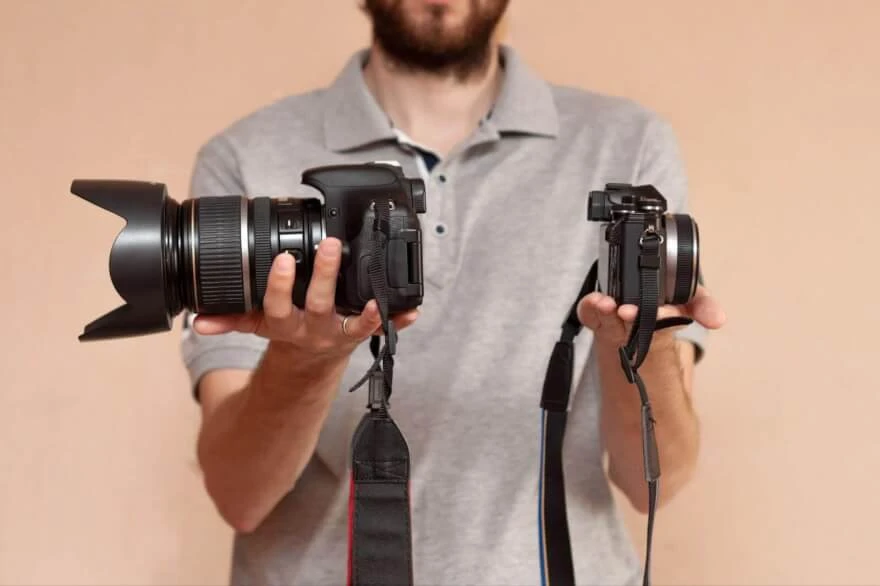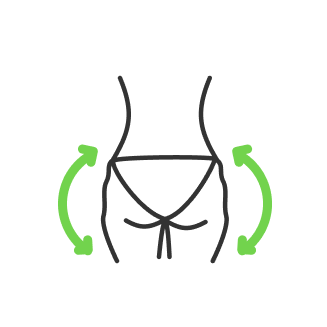Mirrorless vs DSLR Camera

- DSLR setup
- Mirrorless setup
- Similarities
- Viewfinder comparison
- Pros of a Mirrorless Viewfinder
- Cons of a Mirrorless Viewfinder
- DSLR viewfinder
- Shutter speed
- The noise comparison
- Mirrorless vs DSLR Focusing features
- Tracking features
- Sensor stabilization
- Can I use Mirrorless lens on DSLR?
- Size and form factor
- Battery Life
- What is better Mirrorless or DSLR?
- Difference between point and shoot and mirrorless camera
- What is a DSLR camera vs point and shoot?
To have a better understanding of these two types of cameras we need to break down them in comparison. And to do so let us see how they work and all the internal mechanical and software features are out there. We will compare them in multiple different matters such as internal setup, focusing features, convenience, form factors, shutter speed features battery life, and a lot more.
DSLR setup
DSLR stands for Digital Single Lens Reflex. These cameras have a mirror in front of a sensor and the mirror serves a couple of purposes.
When you are not in the middle of taking a photo the mirror is down in front of the sensor and is directing the light coming through your lens upward to what is called a pentaprism which again directs the light into the viewfinder and your eye. As such the image you see in the viewfinder is the real light and image your camera lens is looking at. This is called an optical viewfinder. When you want to take a photo you press the shutter button and the camera raises the mirror to expose the shutter in front of the sensor to light. And then the shutter goes up to reveal the sensor. As you can see there are a lot of moving parts here.
Mirrorless setup
A mirrorless camera has a different setup. Rather than having an optical viewfinder, it has a small electronic display in the viewfinder which shows you what the sensor is seeing in real time, like a little TV. Given there is no need to send an optical image to the viewfinder there is no need for the mirror assembly in the flipping up and down mechanism. The sensor and shutter are just exposed to the front of the camera where the lens is. So most mirrorless cameras just have a mechanical shutter in front of the sensor to help take an exposure. Some cameras are even being made without any shutter at all and just reads the information digitally which we call an electronic shutter.
Similarities
DSLR can almost act like a mirrorless camera when in a live view. That is when the mirror is up, and you are looking at the back LCD. Note though that the viewfinder does not work in this mode. So let's get into the differences between these cameras.
Viewfinder comparison
Let us start with something we have already looked at the viewfinder for both examples.
Pros of a Mirrorless Viewfinder
As we saw a mirrorless camera has an electronic viewfinder. There are some advantages to this. First, the image shown in the viewfinder is adjusted to the exposure that your current settings will take so if the photo is going to be too bright or too dark you see this in real-time, allowing you to adjust the exposure. You can even see a little histogram in the viewfinder and lots of other things can be shown including zebras and the setting details. These are huge benefits. If your photo is underexposed or overexposed a view from the viewfinder tells you, and you can adjust the settings on your camera before hitting the shutter button.

Cons of a Mirrorless Viewfinder
On the downside of electronic viewfinders or EVFs, some people do not like the look of an electronic viewfinder, especially the first mirrorless cameras that were on the market. The color balance may be a bit off compared to what your eye expects, and the resolution may be less than your Optical viewfinder. There may also be blackouts when your camera is taking exposures. That being said, many of these issues are being tackled by camera manufacturers and more recent models are looking more and more like Optical viewfinders.
DSLR viewfinder
On DSLR the viewfinder does not show you what the exposure will look like if your photo is going to be over or under exposed you got some indication by using the light meter, but you do not know until after the photo was taken. Take a picture and either look at the back LCD or find out when get home if the photo was properly exposed.
An extra note on a DSLR reviewing your images on the back LCD on a bright sunny day can be very difficult because the light washes out the LCD. On a mirrorless camera, you can also review your images by looking into the EVF which is a very handy feature.

Shutter speed
One thing that mirrorless cameras are also bringing to the table is that higher shutter speeds can be achieved with no mirror box needing to be moved up and down with every exposure. As such, we are seeing mirrorless cameras with really high shutter speeds which sometimes come with electronic shutter exposures of 30 or more photos per second while not a huge benefit from a portrait or landscape photographer for wildlife and sports this is a great opportunity to catch just the perfect moment. Electronic shutters can render fast-moving subjects out of shape through an effect called a rolling shutter. So it may not be appropriate for every use.
The noise comparison

Another advantage that mirrorless cameras are bringing to the table is silent shooting. That is because they do not need to be raising that mirror up and down out of the way which contributes to some of the noise made by DSLRs when taking a photo. Combined with an electronic shutter to take an exposure, mirrorless cameras can operate completely silently. Weddings, chess matches, recitals, or any other venue we are making clicking sounds would be out of place, silent shooting is a big plus.
Mirrorless vs DSLR Focusing features
The ability to focus is one area that may have started as a disadvantage for mirrorless but is transitioning into an advantage. That is because early mirrorless cameras were not always competing with DSLRs for Focus ability and speed, DSLRs had mastered the use of phase detect autofocus and were very reliable and quick. But the early use of contrast-based focus systems in mirrorless cameras had not yet been fine-tuned to the same ability. Some contrast-based autofocus systems popular in mirrorless cameras also suffer from getting stuck in the background. When something shows up very close to you, the autofocus won’t pull back because your subject is too out of focus. This has been an issue but many of the newest mirrorless cameras have solved this.
All this being said, newer high-end mirrorless cameras are doing things that DSLRs could not do. One is eye detection which is often paired with mirrorless. The ability to find and lock onto the eyes is a great benefit to Wildlife, photographing pets, weddings, or portrait photographs. We are often getting the eye in focus is an important goal.
Tracking features
Another variant of this subject is tracking which works similarly but is looking for moving subjects like cars, airplanes, or any other objects. One of the main benefits of eye or subject detection is that the whole or most of the sensor can be used for it, where DSLRs often have their focus points in the center of the frame. That means we no longer have to worry about focus and recompose which is a technique used with DSLRs to put your subject on the edge of the frame. With mirrorless just find your subject in the frame and place it anywhere to compose the shot and the focus will stay locked onto it.

In summary though while top-tier mirrorless are outperforming DSLRs with autofocus this is not a universal win. The best DSLRs are still outperforming many entry-level mirrorless cameras. The trend though is showing that mirrorless capabilities are improving all the time and continue breaking new ground and autofocus capabilities. And some manufacturers seeing all the benefits are putting their top-tier autofocus capabilities even into their base models.
Sensor stabilization

We have long had stabilization in lenses this is a great feature smoothing out camera movement and helps us get sharper photos with lower shutter speeds. But this has now been added to the sensors of some mirrorless cameras and goes by the name IBIS (in-body image stabilization). It is a great benefit for getting sharp photos and steady video footage. This is actually an additive benefit to the stabilization of the lens, so they work together. It can allow people to take ridiculously long exposures handheld like half a second or even a full second. This technology does not really work well with DSLRs because the mirror blocks the sensor where all this magic happens. As such this is a mirrorless feature but not one offered on all models. Some of the base model mirrorless may not have it. Not have it note that sensor stabilization mitigates camera movement, not subject movement. If your subject moves in the middle of your exposure and you do not have enough shutter speed to freeze it, your subject will be blurry in the photo.
Can I use Mirrorless lens on DSLR?
Now let us talk about lenses. This one is a mixed bag. The good news is that most DSLR lenses can be adapted to mirrorless and work quite well.

The adapter is used to make up the space that the mirror assembly took and allows you to use your DSLR lenses on your mirrorless camera. The reason this is so important is you can transition your camera body to mirrorless and keep using your old DSLR lenses. You can transition to mirrorless lenses over time. And these adapters do not impact image quality. That is because all they are is a spacer to replace the depth that is in the mirror assembly a

DSLR occupies with contacts for the electronics in your camera and your lens to be able to talk to each other, there is no glass in them. On the downside, there are not as many lenses yet in the market for mirrorless systems. And the used lens market is not as robust. Some lens options are very expensive, and some manufacturers are not allowing third-party manufacturers like Sigma Rokinon or Tamron to make lenses for them. These are all issues but at least using older DSLR lenses is a great mitigation for this.
Size and form factor

The issue of the size of cameras is favoring mirrorless. As the lack of a mirror assembly gives the manufacturers more choice in camera size. That being said, there is a trend not to make cameras too small and dainty, some DSLRs provide a robust feeling body even with mirrorless we want a good grip and not have that little finger falling off the bottom of the camera.
Optical designers are also taking advantage of the lack of a mirror assembly. This allows them to place the lens closer to the sensor, adding some flexibility in design options.
Battery Life

One thing that concerns people getting into mirrorless is battery life. There is a valid reason for this. That is because the viewfinder is electronic meaning there is some power needed to keep showing you what the camera is seeing. Some also have sensor stabilization needing even more power. As such some of the first mirrorless cameras to come out had battery life much less than comparable DSLRs. Some were downright bad. There is a standard battery life measure called a CIPA rating (Camera and Imaging Production Association). It is designed to provide the worst-case scenario under very controlled conditions. For example, the Canon R5 CIPA rating is 490 shots, but you may get 1500 to 2000 photos per battery which is fine. But because people have heard about battery life issues they are looking up the CIPA ratings for the first time and seeing rantings like four or five hundred shots per battery and getting scared by it. The recent cameras are closing the gap. The battery life of mirrorless cameras is going up all the time. In some styles of Photography that take tons of exposures, mirrorless can come close to DSLRs because they do not need to use energy raising that mirror out of the way for every shot. On average, you will be issuing about 5 to 10 percent less battery life on mirrorless than on DSLR. So in the end, make sure to test that on your personal experience more than comparing written CIPA ratings that may confuse you. To extend your battery life lower the timer on EVF and LCD to turn off after less time. Turn off GPS and Wi-Fi and Bluetooth off when not using them and enable airplane mode if you have it. And also do not have your EVF and LCD at maximum brightness.
What is better Mirrorless or DSLR?

So if you are considering switching to mirrorless, what do you need to think about?
- Make sure that you can adapt your DSLR lenses to your mirrorless.
- Make sure that a little bit less battery life is OK or consider getting a battery grip if this is a critical issue.
- Be warned, an electronic viewfinder feels a bit weird the first time but will likely pass with time.
- Make sure that the lenses you want in the future are both available and affordable.
Note that switching to mirrorless will not make you a better photographer all of a sudden. It won’t get you out of bed at 2 AM to go out and get a Milky Way photo or help you find better compositions or make amazing action happen right in front of you. But it will send you home with more keepers, get you more properly exposed photos more often, won’t disturb a silent hall for a recital, will deliver sharper images at low shutter speeds with IBIS, and give you a smaller form factor.
Difference between point and shoot and mirrorless camera

If we compare point and shoot vs mirrorless there is not much to say. Nowadays point and shoot cameras are so outdated that even smartphone cameras outperform point & shooters. That is all because of the AI machine learning and the interfaces that allow your smartphone camera to understand what you are looking at in advance and make adjustments on the fly. Mirrorless vs point and shoot comparison has no actual competition and has the most use for people who do not want to learn a bit about photographing and want just really point-and-shoot and that’s it. P&S cameras have auto settings for focus and exposure which is a good way to introduce yourself into photography as a beginner.

What is a DSLR camera vs point and shoot?
If we compare DSLR camera vs point and shoot, the only reason you may prefer the 2nd one is the complexity of the device. As we mentioned earlier, point-and-shoot is for beginners, when DLSR is made for dedicated photographers and the overall gear is less affordable. That is the main difference between DSLR and point and shoot cameras – convenience on a beginner level. The convenience between mirrorless camera vs point and shoot are represented only by a form factor. You can take point and shooter in your pocket anywhere, but in this case, you can also take your smartphone instead for the same outcome. Point-and-shoot cameras may provide some nostalgic grace to the crowd as they are historically more familiar with these moments when doing family photos with their parents when smartphones were not that popular yet.
Co-founder of RetouchMe. In addition to business, he is passionate about travel photography and videography. His photos can be viewed on Instagram (over 1 million followers), and his films can be found on his YouTube channel.
Moreover, his profile is featured on the most popular and authoritative resource in the film industry — IMDb. He has received 51 international awards and 18 nominations at film festivals worldwide.

with RetouchMe














